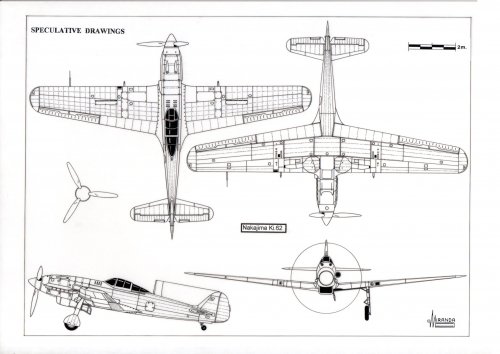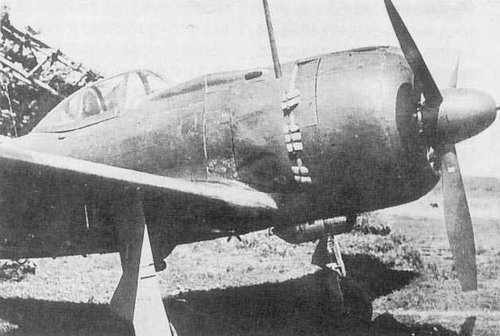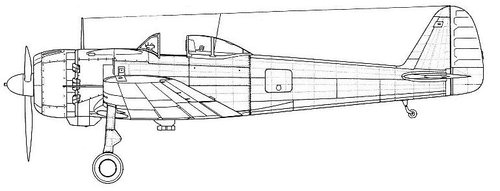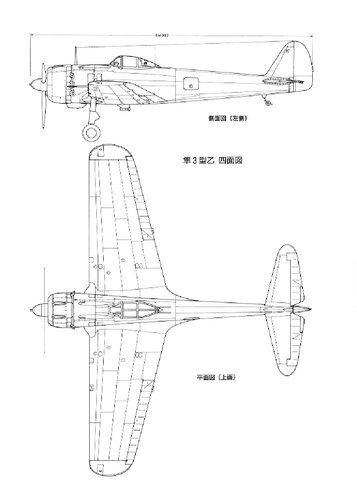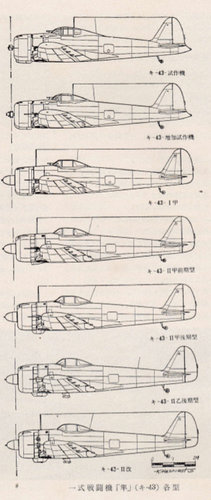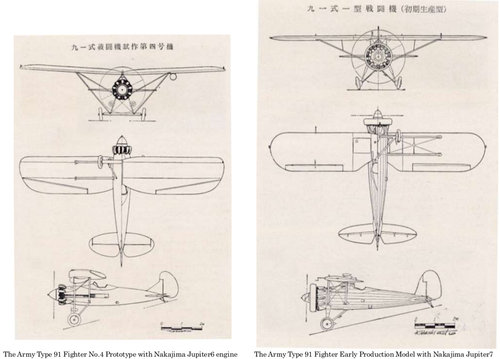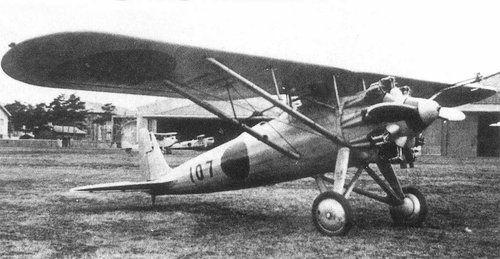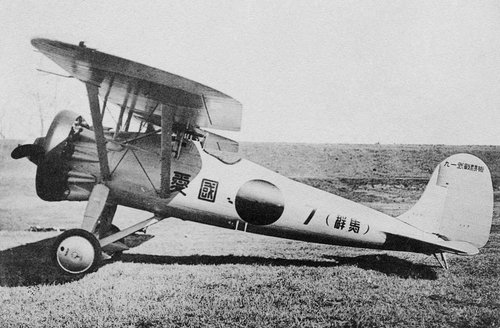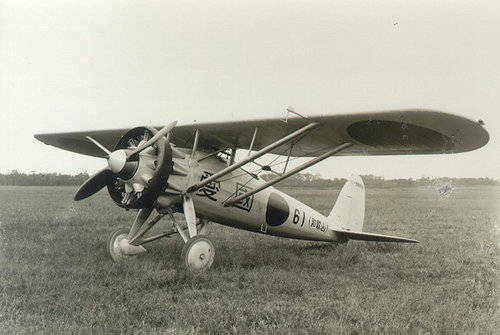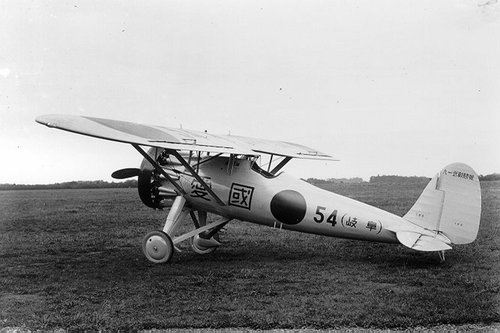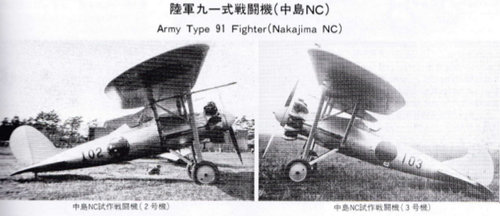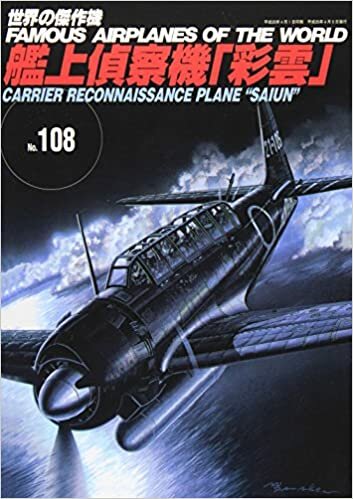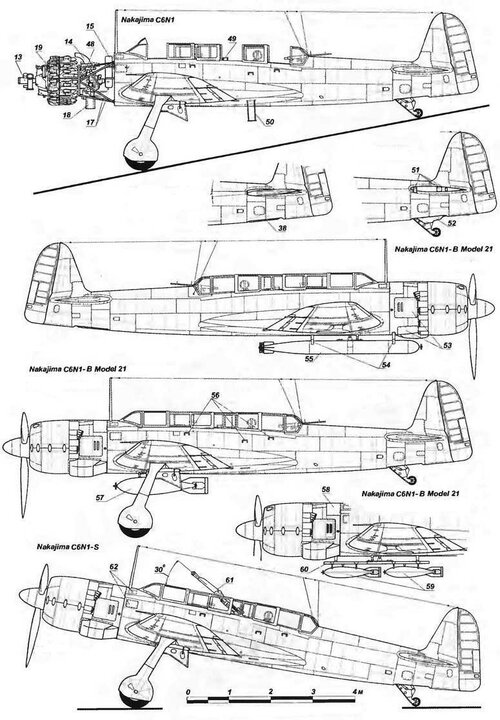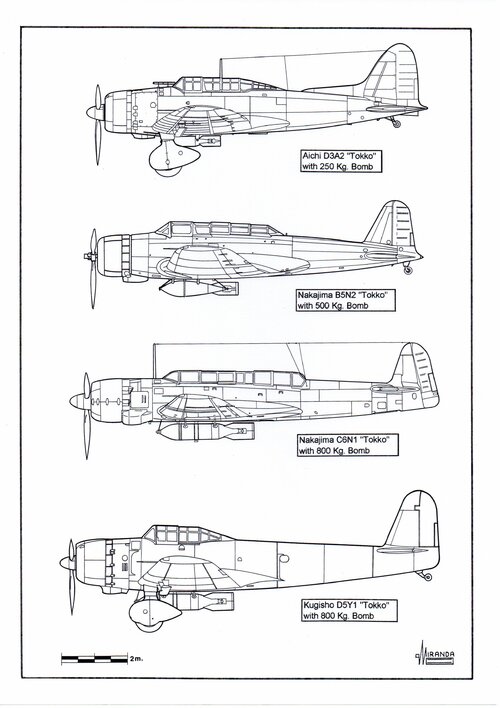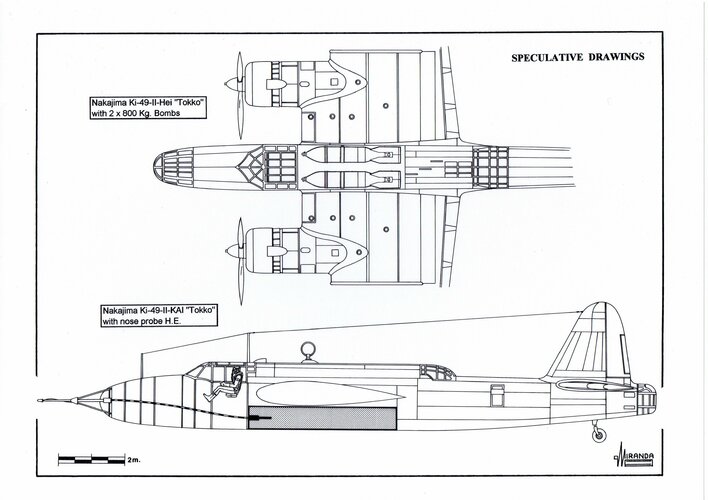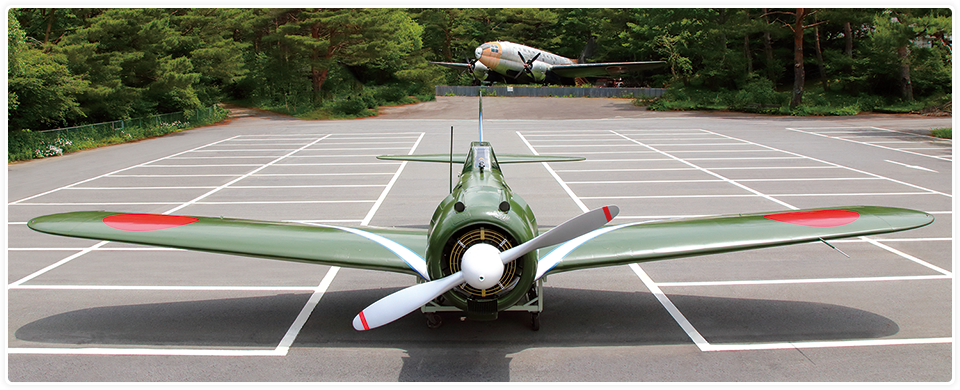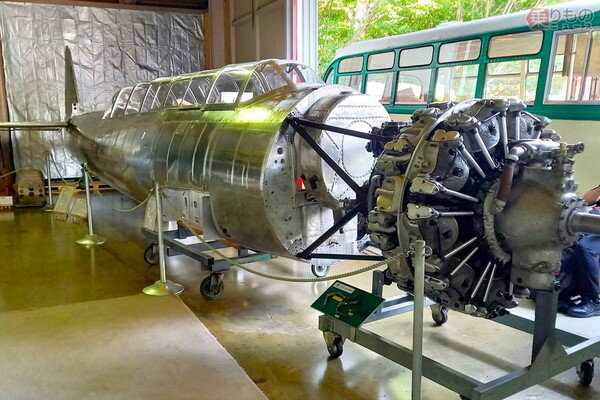You are using an out of date browser. It may not display this or other websites correctly.
You should upgrade or use an alternative browser.
You should upgrade or use an alternative browser.
Various Nakajima projects and prototypes
blackkite
Don't laugh, don't cry, don't even curse, but.....
- Joined
- 31 May 2007
- Messages
- 8,819
- Reaction score
- 7,716
Hi! Experimental Ki-43-Ⅲ Otsu with 20mm cannon.
In order to overcome the firepower that is the weak point of the Hayabusa, this prototype retrofitted 20mm cannon 2. Therefore, a big bulge is attached to the front of the cockpit. In addition, a part of the rear of the fuselage has also been made of wood. However, it ended in the prototype without being adopted.
Source :
In order to overcome the firepower that is the weak point of the Hayabusa, this prototype retrofitted 20mm cannon 2. Therefore, a big bulge is attached to the front of the cockpit. In addition, a part of the rear of the fuselage has also been made of wood. However, it ended in the prototype without being adopted.
Source :
Attachments
windswords
ACCESS: Secret
- Joined
- 19 May 2009
- Messages
- 389
- Reaction score
- 217
blackkite
Don't laugh, don't cry, don't even curse, but.....
- Joined
- 31 May 2007
- Messages
- 8,819
- Reaction score
- 7,716
Attachments
Last edited:
blackkite
Don't laugh, don't cry, don't even curse, but.....
- Joined
- 31 May 2007
- Messages
- 8,819
- Reaction score
- 7,716
blackkite
Don't laugh, don't cry, don't even curse, but.....
- Joined
- 31 May 2007
- Messages
- 8,819
- Reaction score
- 7,716
Last edited:
Airborne2001
ACCESS: Secret
- Joined
- 19 June 2020
- Messages
- 224
- Reaction score
- 278
Does anyone know how the C6N5 differed from the C6N1-B?
blackkite
Don't laugh, don't cry, don't even curse, but.....
- Joined
- 31 May 2007
- Messages
- 8,819
- Reaction score
- 7,716
The experimental Saiun Type 21 and the Experimental Saiun Modification Type 3
It is said that the carrier-based attack aircraft type of Saiun was born from the viewpoint of model integration, and was planned to be called the Experimental Saiun Type 21 (C6N1-B).
On the other hand, there is a opinion that the aircraft called the Experimental Saiun Modification Type 3 (C6N5) was a carrier-based attack aircraft type.
Source : FAMOUS AIRPLANES OF THE WORLD No.108 CARRIER RECONNAISSANCE PLANE "SAIUN" page26.
It is said that the carrier-based attack aircraft type of Saiun was born from the viewpoint of model integration, and was planned to be called the Experimental Saiun Type 21 (C6N1-B).
On the other hand, there is a opinion that the aircraft called the Experimental Saiun Modification Type 3 (C6N5) was a carrier-based attack aircraft type.
Source : FAMOUS AIRPLANES OF THE WORLD No.108 CARRIER RECONNAISSANCE PLANE "SAIUN" page26.
windswords
ACCESS: Secret
- Joined
- 19 May 2009
- Messages
- 389
- Reaction score
- 217
- Nakajima C6N Saiun
The Nakajima C6N was designed as the successor of the Aichi D4Y. The Saiun was a fast carrier-based, long-range reconnaissance airplane, almost immune to Allied interception. Airframe structure was very light, with six unprotected fuel tanks located inside the wings, features that made it very vulnerable to battle damage.
With the same maximum speed than the Hellcat and 12,500 m of absolute ceiling, the Saiun could travel 3,000 nautical miles with a ventral fuel tank of 762 litres, eluding all Allied fighters with the exception of the Mustang. The C6N was too valuable for the IJN intelligence services, for its ability to locate Allied fleets, and only intervened in the kamikaze offensive marginally.
On November 26, 1944, a plane of the 752nd Kokutai, with very experienced crew, acted as guide to twelve Zeros A6M5 of the 1st Mitate Special Strafing Unit, on a mission of no return against the base of B-29s of Isely Field, located in Saipan. During the spring of 1945 some Saiun of the 732nd and 752nd Kokutais were modified to carry out Tokko missions organized in the Saiun and Sairyu suicide units.
The structural weakness of the aircraft did not allow the installation of a bomb under the fuselage and had to be renovated according to the existing plans for the future version of bombardment C6N1-Ko Mod.21. The wings were probably strengthened, eliminating the external tanks of 1,921 litres and installing a 800 kg bomb that was bolted under the centre section of the wing.
Two C6N were also modified as night fighters, with a 20 mm cannon in
Schräge Musik configuration, installed behind the pilot. There are no records of any engagement in fighting by these aircraft and it is unknown if they had any success against the B-29s.
Attachments
- Nakajima Ki.49 Helen
During the summer of 1938 Japanese bombers of the type Ki-21 suffered heavy casualties in China against the Polikarpov I-16 fighters piloted by Soviet volunteers, Their targets Lanchow and Chungking were too far away and the Nate fighters could not escort them.
The experiences of the war in China led the IJA to encourage the construction of bombers capable of self-defending. The ideal solution would have been a four engine airplane similar to the B-17 or an unarmed fast bomber similar to the British ‘Mosquito’. But the IJA decided to draw on the French multiplaces de combat building an airplane the size of a B-25 defended by six gunners, pilot armour and self-sealing fuel tanks. Known as Ki.49, this aircraft was underpowered and overweight and had poor handling and landing performances with a maximum payload of 1,000 kg of bombs.
Despite its armament and protection, the Helens suffered heavy losses in New Guinea in 1942 and in Philippines in 1944. Many were assigned to secondary tasks of transportation, courier and anti-submarine patrol. Some were transformed into night fighters with one 75 mm Type 88 antiaircraft cannon, in an attempt to face the B-29 with heavy armament. These aircraft should operate in pairs with other Ki.49s equipped with a searchlight nose, similarly to the ‘Turbinlite’ squadrons of the RAF and with the same lack of success than these.
When the Allied forces landed in Mindoro Island in December 1944, the IJA ordered the formation of the suicidal Kikusui unit, equipped with nine Helens from the 95th Sentai. The crew was reduced to two men, all the armour armament and auxiliary equipment were removed and two No 80, Model 2, 807.5 kg antiship bombs were installed in the bomb bay. On December 14, all modified Ki.49s, escorted by three Oscars of the 13rd Sentai, took off from Negros airfield to attack US ships off Mindanao, but the twelve aircraft were shot down by US fighters.
In late 1944, some experiments were made in the Tochigi Test Center, located north of Japan, with the Ki.49-II-Hei of the 74th Sentai, equipped with a nose probe similar to that used by the Ki.48s. But it is ignored if the modification was performed in more airplanes. In August 1945, the training suicidal unit Shinbu Tai No. 47 was being formed using Tokko modified aircrafts from the Hamamatsu Instructing Flying Division. Some Helens were also used for transporting suicide paratroops during Operation Te-Go. On December 7, four Ki.49 and thirty-two Ki.57 that carried two regiments of the First Airborne Brigade, made crash landings on the airfields of San Pablo, Tacoblan, Dulag and Burauen that were simultaneously bombarded by another eleven Ki.49s.
Attachments
windswords
ACCESS: Secret
- Joined
- 19 May 2009
- Messages
- 389
- Reaction score
- 217
Had it run into the P-47N Thunderbolt it would have been caught as it was significantly faster at altitude than the Mustang (top speed of 467 mph/751.5 kph). There were four or five such units stationed at Iwo Jima and Okinawa in the last months of the war.eluding all Allied fighters with the exception of the Mustang.
Had it run into the P-47N Thunderbolt it would have been caught as it was significantly faster at altitude than the Mustang (top speed of 467 mph/751.5 kph). There were four or five such units stationed at Iwo Jima and Okinawa in the last months of the war.eluding all Allied fighters with the exception of the Mustang.
True. But I suspect that, given enough of an initial altitude advantage, a C6N would still have a good chance of evading interception most of the time.
High top speed would only be decisive once the Thunderbolt or Mustang had climbed up to more or less the same altitude as the C6N. While gaining height, an interceptor necessarily falls behind its target and has to make up the difference, and the target can always trade some height for more speed, compounding the fighter's problems. If the C6N crew kept a good lookout, I suspect that they'd have a fair chance of outrunning their pursuers despite the paper performance advantage.
I don't know anything about the handling characteristics of these aircraft at altitude, but I'd expect maneuvering to be difficult and stalling to be a problem. So, even after the fighter reached the target's attitude and closed the range, it might still have problems. The C6N's light construction might give it enough of an advantage under such conditions to make getting into firing position difficult.
I'm speculating, of course. But there are precedents. Ju86Ps consistently evaded high-alititude Spitfire and Mosquito fighters due to the long climb to height and the difficulty of simultaneously maintaining control and achieving a firing position. Mosquitoes likewise evaded late-model Bf109s and Fw190s by trading height for speed. Light weight and good high-altitude handling even allowed piston-engined Mosquitoes and RB-36s evade early jets like the Me262 and MiG-15.
windswords
ACCESS: Secret
- Joined
- 19 May 2009
- Messages
- 389
- Reaction score
- 217
As for the P-47N (and all it's previous models), unlike the other fighters mentioned it was in it's element at high altitude in terms of speed, climb and even turn were more than competitive. At lower altitudes it would be at a disadvantage compared to a Hellcat or Corsair. I don't think the C6N would have had any advantages at altitude. The top speed is for the C6N1 is 610 km/h (380 mph) at 6,100 m (20,013 ft). For the P-47N it is just under 450 mph at 25,000 feet, so more than enough to intercept the C6N1 even if at top speed at 20,000. The Thunderbolt will have to be already airborne and above 10,000 feet as its climb rate is slower than its contemporaries, but that is really no different than any other interceptor, if they are not already airborne at a significant height the C6N will be gone from the area before it can intercepted.
In your previous comment you mentioned the Ki-49 night fighters version with one 75 mm Type 88 cannon. I know of this conversion with the Ki-67 Peggy bomber to produce the Ki-109. Do you have any drawings of this version of the Ki-49?
In your previous comment you mentioned the Ki-49 night fighters version with one 75 mm Type 88 cannon. I know of this conversion with the Ki-67 Peggy bomber to produce the Ki-109. Do you have any drawings of this version of the Ki-49?
NoAs for the P-47N (and all it's previous models), unlike the other fighters mentioned it was in it's element at high altitude in terms of speed, climb and even turn were more than competitive. At lower altitudes it would be at a disadvantage compared to a Hellcat or Corsair. I don't think the C6N would have had any advantages at altitude. The top speed is for the C6N1 is 610 km/h (380 mph) at 6,100 m (20,013 ft). For the P-47N it is just under 450 mph at 25,000 feet, so more than enough to intercept the C6N1 even if at top speed at 20,000. The Thunderbolt will have to be already airborne and above 10,000 feet as its climb rate is slower than its contemporaries, but that is really no different than any other interceptor, if they are not already airborne at a significant height the C6N will be gone from the area before it can intercepted.
In your previous comment you mentioned the Ki-49 night fighters version with one 75 mm Type 88 cannon. I know of this conversion with the Ki-67 Peggy bomber to produce the Ki-109. Do you have any drawings of this version of the Ki-49?
- Joined
- 26 May 2006
- Messages
- 34,899
- Reaction score
- 15,760
Hi,
has anyone more info about these Nakajima Projects ?;
- A6N fighter
- 18-shi Carrier-based attack aircraft
- Type 2 Seaplane
- Special attack aircraft (1945)
- 19-shi reconnaissance carrier-based aircraft
- 20-shi local fighter
has anyone more info about these Nakajima Projects ?;
- A6N fighter
- 18-shi Carrier-based attack aircraft
- Type 2 Seaplane
- Special attack aircraft (1945)
- 19-shi reconnaissance carrier-based aircraft
- 20-shi local fighter
Last edited:
jackssmirkingrevenge
ACCESS: Restricted
- Joined
- 5 July 2023
- Messages
- 22
- Reaction score
- 73
Footage of the Type 91 in Kyoto in 1932
- Joined
- 26 May 2006
- Messages
- 34,899
- Reaction score
- 15,760
Hi,
has anyone more info about these Nakajima Projects ?;
- A6N fighter
- 18-shi Carrier-based attack aircraft
- Type 2 Seaplane
- Special attack aircraft (1945)
- 19-shi reconnaissance carrier-based aircraft
- 20-shi local fighter
That's proof,Nakajima designed a proposal for A6 competition,but not proceeded with.
- Joined
- 25 June 2009
- Messages
- 14,753
- Reaction score
- 6,147
Quoting your own request list is hardly "proof" of anything, just sayin'...That's proof,Nakajima designed a proposal for A6 competition,but not proceeded with.
- Joined
- 26 May 2006
- Messages
- 34,899
- Reaction score
- 15,760
Quoting your own request list is hardly "proof" of anything, just sayin'...
I hope to be not reject anything,just for objection,I displayed this informations before in some
topics from Japaneses Wikipedia itself ?!.
Airborne2001
ACCESS: Secret
- Joined
- 19 June 2020
- Messages
- 224
- Reaction score
- 278
I think hesham meant moreso that the designation itself is proof of the type, not that them saying it is proof.Quoting your own request list is hardly "proof" of anything, just sayin'...
- Joined
- 26 May 2006
- Messages
- 34,899
- Reaction score
- 15,760
I think hesham meant moreso that the designation itself is proof of the type, not that them saying it is proof.
As I mentioned before,the Japanese encyclopedia of aircraft on Wikipedia is the source for them,but I
can't find or access to it again ?!.
- Joined
- 26 May 2006
- Messages
- 34,899
- Reaction score
- 15,760
Hi,
has anyone more info about these Nakajima Projects ?;
- A6N fighter
- 18-shi Carrier-based attack aircraft
- Type 2 Seaplane
- Special attack aircraft (1945)
- 19-shi reconnaissance carrier-based aircraft
- 20-shi local fighter
That's all I found in my files,the Google translate,
blackkite
Don't laugh, don't cry, don't even curse, but.....
- Joined
- 31 May 2007
- Messages
- 8,819
- Reaction score
- 7,716
Hi!
KAWAGUCHIKO MOTOR MUSEUM / KAWAGUCHIKO ZERO FIGHTER MUSEUM
Kawaguchiko Motor Museum・ZeroFighter Museum - Official website - 10am to 4pm every day in AUGUST Open (closed the rest of the year)
www.car-airmuseum.com
Attachments
blackkite
Don't laugh, don't cry, don't even curse, but.....
- Joined
- 31 May 2007
- Messages
- 8,819
- Reaction score
- 7,716
Limited release in August every year. Lake Kawaguchi "Flying Pavilion" Kawaguchiko Automobile Museum / Flight Hall
View: https://www.youtube.com/watch?v=8FH4FaQC2_0
blackkite
Don't laugh, don't cry, don't even curse, but.....
- Joined
- 31 May 2007
- Messages
- 8,819
- Reaction score
- 7,716
This Saiun reconnaissance aircraft was found on Weno Island in the former Truk Islands (now Chuuk Islands), and the wreckage, including part of the fuselage and wing, was recovered. Restoration work is currently underway using the remains of these debris.
Attachments
Similar threads
-
-
-
other less known japanese aircraft projects
- Started by airman
- Replies: 14
-
Aichi Experimental Two-Seat Reconnaissance Seaplane (AM-10)
- Started by blackkite
- Replies: 0
-
Nakajima NAF-1 and NAF-2 two-seat fighters
- Started by blackkite
- Replies: 13

